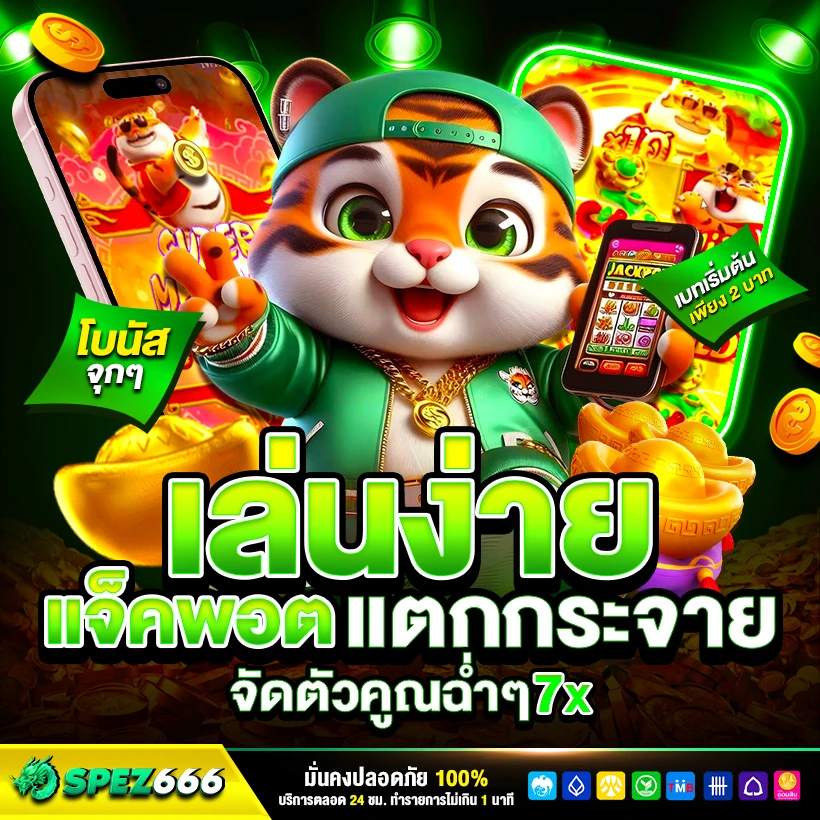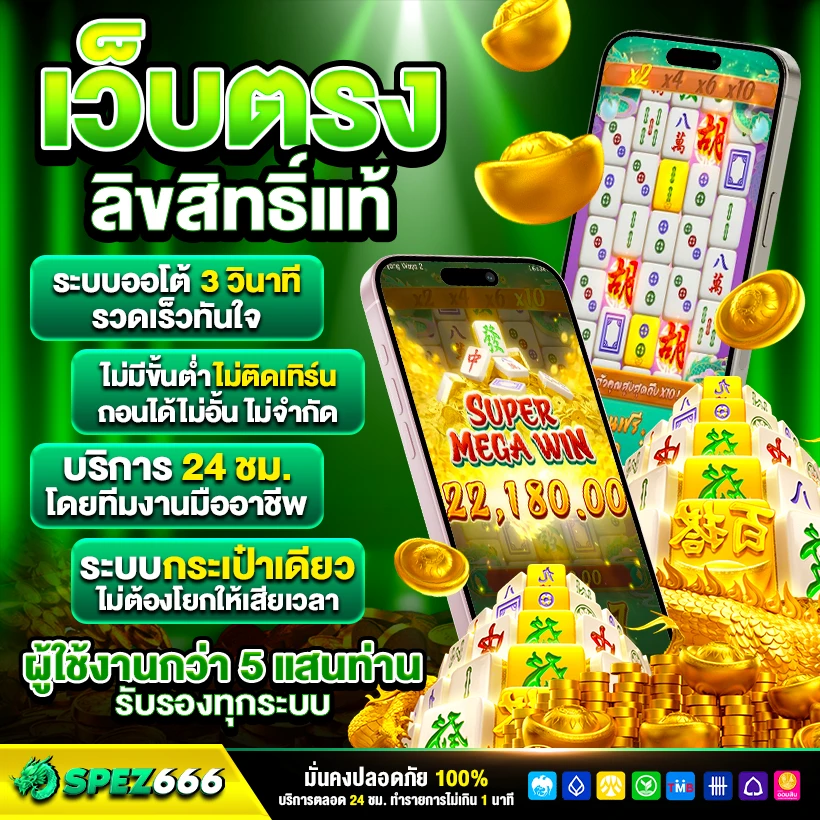



สล็อตเว็บตรง ฝากถอนทรูวอเลท เว็บสล็อต ใหม่ล่าสุด ไม่มีขั้นต่ำ ทางเลือกที่ดีที่สุดสำหรับนักเดิมพัน ที่อยากเล่นเกม สล็อต777 ออนไลน์โดยไม่ผ่านเอเย่นต์ ที่สำคัญยังมีความสะดวกสบายในการทำธุรกรรมที่รวดเร็ว และที่เด็ดสุดคือ เล่นสล็อต แตกง่าย ได้เงินจริง ถ้าคุณอยากรู้ว่าทำไม เว็บสล็อต อันดับ 1 นี้ถึงเป็นที่นิยม อ่านต่อกันเลย รับรองว่าไม่ผิดหวัง
อยากเล่นสล็อตออนไลน์ที่ได้เงินจริง ต้องสมัครสมาชิกบน เว็บตรง ที่ดีที่สุดกำลังรอคุณอยู่ เข้ามาเล่น สล็อตแตกง่าย และแตกบ่อยที่สุด ทุกเกมส่งตรงจาก ต่างประเทศ รับรองว่าเล่นสนุก เพราะมีการอัพเดทเกมใหม่ล่าสุด มั่นใจได้ว่า เว็บสล็อต ทำกำไรได้จริง ไม่มีเบื่อ ถ้าอยากรู้ว่าเว็บไหนปังสุด ต้องห้ามพลาด
ถ้าคุณกำลังมองหาเว็บสล็อตออนไลน์ แตกหนัก แตกจริง ต้องเว็บใหม่ล่าสุด 2025 ที่มีระบบฝากถอนทรูวอเลท ไม่มีขั้นต่ำ ที่ดีที่สุด คือคำตอบที่พลาดไม่ได้ สนุกไปกับเกมออนไลน์ที่ได้เงินจริง เว็บตรง 100 % ใช้ True Wallet ทำธุรกรรมง่าย ๆ สล็อต ฝากถอนไม่มีขั้นต่ำ แค่ 1 บาท ก็ฝากหรือถอนได้เงินจริง เริ่มต้นเล่น สล็อตเว็บตรง ได้ทันที สล็อตเว็บตรงฝากถอน true wallet ไม่มีขั้นต่ำ ทำกำไรได้จริงจาก เกมสล็อตเว็บตรง สุดทันสมัยและปลอดภัยที่สุด อย่าพลาดโอกาสเล่นสล็อตดีที่สุดในตอนนี้ เว็บสล็อตตรง พร้อมให้บริการทุกคนแล้ว
สล็อตเว็บตรง คือ เว็บพนันออนไลน์ ไม่ผ่านเอเย่นต์ ที่ทำให้คุณมั่นใจในความโปร่งใส และปลอดภัย เพราะ สล็อตเว็บตรง 777 ไม่มีคนกลางมาเอากำไรจากคุณ การฝาก-ถอนก็สะดวกและรวดเร็วผ่านระบบ สล็อต เว็บตรง ฝากถอน ไม่มี ขั้น ต่ำ true wallet เริ่มต้นแค่ 1 บาทก็เล่นได้ นอกจากนี้ สล็อตเว็บตรง100% ยังมีโปรโมชั่นดี ๆ รอคุณอยู่ ทำให้คุณมั่นใจในการเดิมพันสล็อตได้เต็มที่ ว่าจะได้รับเงินเมื่อเล่นเกมสล็อตชนะ สามารถรับได้เต็มจำนวนจากเกมที่เล่น ไม่ต้องกังวลเรื่องค่าธรรมเนียมหรือการหักค่านายหน้าใด ๆ ดังนั้น ถ้าอยากเล่น สล็อตวอเลท ที่ปลอดภัยที่สุด ลองเข้ามาเล่นเว็บคาสิโน ไม่ผ่านเอเย่นต์กันเลย
นอกจากนี้แล้วการเข้ามาเล่น เว็บสล็อตเว็บตรง ที่มี ทรูวอเลท จะทำให้การทำรายการ ฝากถอน ง่ายมากยิ่งขึ้น ซึ่งสามารถทำรายการได้ทันที โดยที่ไม่มีขั้นต่ำ แม้ไม่มีบัญชีธนาคาร ก็สามารถเข้าถึงได้อย่างง่ายดายภายใน สล็อตเว็บตรง ที่มีระบบที่ทันสมัย แตกต่างจากเว็บเอเย่นต์ ที่ต้องทำรายการโดยใช้ทีมงานนั้นเอง นอกจากนี้แล้ว ทางเว็บสล็อตแท้ ยังมีบริการมากมาย ไม่ว่าจะเป็นด้านโปรโมชั่น หรือ ระบบเกมสล็อตที่มี APIแท้ ส่งตรงมาจากคาสิโนของจริง ทำให้การเล่นมีโอกาส แตกง่าย มากยิ่งขึ้น
เว็บเกมที่แตกง่ายและปลอดภัยที่สุด ที่ใครๆก็มองหา เล่นกับ สล็อตเว็บตรง 100 % เว็บไซต์ของเรารับประกันมีความโปร่งใส และความมั่นใจ เพราะเรามีเกม สล็อตเว็บตรง ลิขสิทธิ์แท้จากค่ายดัง อย่าง เว็บสล็อต pg เว็บตรง ทำให้คุณสามารถเล่นเกมบน เว็บตรงสล็อต ไม่ผ่านเอเย่นต์ได้ โดยไม่มีความกังวลเกี่ยวกับการถูกโกง หรือการหักค่าคอมมิชชันใด ๆ เว็บตรง 100% ของเรามีระบบที่ปลอดภัย เล่นสล็อตได้ทั้งวันทั้งคืน และยังมีโบนัสพิเศษให้ลุ้นอีกมากมาย ถ้าคุณอยากสัมผัสประสบการณ์เล่นเกมที่ดีที่สุด ต้องห้ามพลาดดังนี้
หากคุณอยากเล่นเกมที่ทั้งปลอดภัย และน่าเชื่อถือ ต้อง สล็อตเว็บตรง รองรับ สล็อตทรูวอเลท คือคำตอบ ระบบรักษาความปลอดภัยที่แข็งแกร่ง ทำให้คุณเล่นได้อย่างสบายใจ ฝาก-ถอนสะดวกและรวดเร็ว ไม่ต้องกังวลเรื่องการโกง สนุกไปกับเกมออนไลน์ที่ได้มาตรฐาน ความปลอดภัยระดับสูง รับรองว่าเล่นเกมกับ เว็บตรง ได้เต็มที่ ไม่มีปัญหา
การจ่ายเงินตรงไปตรงมา คือสิ่งที่ เว็บตรง ทำได้ดีที่สุด ค่ายเกมสล็อต ลิขสิทธิ์แท้จะไม่ทำให้คุณผิดหวัง เพราะทุกการเดิมพันจะได้รับการจ่ายเงินอย่างโปร่งใส และตรงไปตรงมา ไม่มีการหักค่าธรรมเนียมหรือเอเย่นต์มาเกี่ยวข้อง เล่นเกมสล๊อตได้สบายใจ รับเงินเต็มจำนวนทุกครั้งที่ชนะ
อยากได้โปรโมชั่นจัดเต็มไหม? มาเลย ไม่ว่าจะเป็น โบนัสสมาชิกใหม่ หรือโปรโมชั่นสุดพิเศษจาก สล็อตพีจี สล็อตเว็บตรง มีให้คุณแบบจุใจ แถมเกมสล็อตเว็บตรงของเรายังแตกบ่อยอีกด้วย รับรองว่าทุกการหมุนเกมสล็อตจะคุ้มค่า และทำให้คุณเพลิดเพลินไปกับการเล่นอย่างแน่นอน มาเก็บความสนุกไปกับสล็อตที่ดีที่สุดกัน
การใช้งานระบบอัตโนมัติในการฝากถอนเงิน ไม่ต้องรอนาน เพราะ เว็บสล็อตตรง มีสล็อตเว็บตรงฝากถอน true wallet ไม่มีขั้นต่ำ แถมไม่ต้องมีบัญชีธนาคาร ก็ทำรายการได้สะดวกสุด ๆ ถ้าอยากเล่นเกมสล็อตสนุก ๆ และทำธุรกรรมรวดเร็ว มาที่เว็บนี้เลย รับรองว่าไม่มีปัญหายุ่งยาก
หากคุณกำลังมองหาเว็บเกมสล็อตออนไลน์ ไม่ผ่านเอเย่นต์ มาใหม่ และเริ่มต้นเพียงแค่ 1 บาท ต้องที่เว็บนี้เลย เกมสล็อตออนไลน์ที่ให้คุณเล่นได้อย่างเต็มที่ พร้อมถอนเงินได้ไม่จำกัดผ่านทรูวอเลท สะดวกและรวดเร็ว ไม่มีขั้นต่ำในการฝาก-ถอน มาพร้อมกับเกม สล็อตต่างประเทศ มาแรง ที่เต็มไปด้วยความสนุกและรางวัลใหญ่ เว็บสล็อต ของเราเป็นเว็บใหม่ล่าสุดที่มาแรง พร้อมมอบประสบการณ์เล่นเกม เว็บสล็อต ที่ดีที่สุดให้คุณ พร้อมรับโบนัส สล็อตค่ายนอก และแจ็คพอต สล็อตมาใหม่ ในทุก ๆ การหมุน ไม่ว่าจะเป็น สล็อตแจ็คพอต หรือเกม slot แตกง่าย มาร่วมสนุกกับ สล็อตเว็บตรง ดีที่สุด เว็บสล็อต อันดับ 1 ที่ให้บริการคุณได้ตลอด 24 ชั่วโมง
คุณเคยเจอปัญหาเล่นเกมสล๊อตแล้วกระตุกไหม? ถ้าไม่อยากเจอปัญหานั้น ลองมาเล่น สล็อตเว็บตรง ที่ใช้ระบบ API ทันสมัยกันดู เกมที่รองรับการเล่นได้ลื่นไหล ไม่มีสะดุด ไม่ว่าคุณจะเล่นจากค่ายเกมสล็อตไหน ก็สามารถเดิมพันได้สบายใจตลอดเวลา ไม่ต้องกลัวการขัดข้อง หรือเสียโอกาสในการทำกำไร แถม เว็บสล็อตทรูวอเลท ของเรายังปลอดภัย ทำธุรกรรมง่าย ๆ ผ่าน เว็บสล็อตวอเลท ได้อย่างรวดเร็ว เว็บตรงสล็อต ที่พร้อมให้คุณเล่นเกม สล็อตออนไลน์ ได้เงินจริง สล็อตเว็บตรง ทันสมัยและมีระบบที่เสถียรที่สุด ไม่ว่าจะเล่นช่วงไหนก็เพลิดเพลินได้เต็มที่ ถ้าอยากสนุกกับเกมแบบไม่มีสะดุด ต้องมาลองที่นี่

ถ้าคุณเป็นคนที่อยากเล่นเกมระบบ สล็อตทรูวอเลท ไม่ต้องกังวลเรื่องขั้นต่ำ ที่นี่ตอบโจทย์สุด ๆ บริการฝากถอน ไม่มีขั้นต่ำ ผ่านระบบ สล็อตเว็บตรงฝาก ถอน true wallet ไม่มีขั้นต่ํา เว็บสล็อต ที่ปลอดภัย เชื่อถือได้ 100% สามารถเริ่มต้นเล่นได้ทันที ด้วยทางเข่าเล่นเกมที่ทันสมัย ปลอดภัย แถมยังมีเกม สล็อตเว็บตรงแตกง่าย ให้คุณเลือกเล่นอีกมากมาย ที่สำคัญเว็บพนันออนไลน์ของเราถูกกฎหมาย มีใบอนุญาต ในการให้บริการ รับรองว่าไม่มีโกงเกิดขึ้นแน่นอน ทุกการฝาก-ถอนรวดเร็วและโปร่งใส ไม่มีขั้นต่ำ ถ้าคุณอยากเล่นเว็บที่มั่นคง ที่เชื่อถือได้จริง ไม่มีขั้นต่ำ ลองมาเล่นที่นี่เลย
จัดเลยมาให้แล้วกับ 6 เว็บสล็อตเว็บตรง ไม่ผ่านเอเย่นต์ ที่คุณไม่ควรพลาด เว็บอันดับ 1 ที่ให้บริการเกมแตกง่าย เชื่อถือได้ ที่สุด ระบบทันสมัย ฝากถอนง่ายไม่มีขั้นต่ำ ผ่านระบบ เว็บสล็อตวอเลท รับรองความปลอดภัย โปร่งใสทุกการทำรายการ อีกทั้งยังมีโปรโมชั่นสุดพิเศษจาก สล็อต PG และ เกมสล็อตเว็บตรง แตกหนัก ไม่มีขั้นต่ำ พร้อมทั้ง สล็อตเว็บตรง มั่นคง ไม่มีโกง เข้าเล่นได้ทุกเวลา และสนุกไปกับประสบการณ์ใหม่ที่ดีที่สุด โดยมี 6 เว็บดังแนะนำดังนี้
อยากทดลองเล่นสล็อตก่อนสมัครจริง ที่ 1XBET มีโหมดทดลองเล่นสล็อตให้ลองเล่นฟรี พร้อมโบนัสสุดคุ้มให้คุณได้ใช้ นอกจากนี้ยังปลอดภัย น่าเชื่อถือ เพราะเป็นเกมสล็อต เว็บตรง ที่ให้บริการอย่างโปร่งใส สมัครก่อนรับรองว่าทุกการเดิมพันของคุณจะเต็มไปด้วยความสนุก และโอกาสทำกำไร
Dragon444 เว็บสล็อตเว็บตรง 100% ที่ปลอดภัยและ น่าเชื่อถือที่สุด เกมแตกง่ายโบนัสจัดเต็ม พร้อมมีโปรโมชั่นพิเศษให้คุณตลอดทั้งเดือน มั่นใจได้ในความโปร่งใส การจ่ายจริง ปลอดภัย เล่นสล็อตได้อย่างสบายใจ เล่น สล็อตเว็บตรง ได้เท่าไหร่ก็ถอนได้ไม่อั้น
Luca77 เว็บสล็อตตรง ที่ ไม่ผ่านเอเย่นต์ เล่นได้ปลอดภัย 100% หากคุณชอบ สล็อต PG ที่แตกง่ายและไม่ต้องทำเทิร์น เว็บสล็อตตรง เว็บนี้ตอบโจทย์สุด ๆ พร้อมให้คุณสนุกไปกับเกมสุดมันส์ และรับเงินจริงโดยไม่ต้องกังวลเรื่องการถอน ถ้าอยากเล่นเว็บที่ ปลอดภัยและโปร่งใส ลองเลย
Huc99 เว็บสล็อต อันดับ 1 ที่ไม่ควรพลาด มาพร้อมระบบฝากถอน ไม่มีขั้นต่ำ เล่นง่ายได้เงินจริง สล็อตคุณภาพสูงจากค่ายชั้นนำ ฟีเจอร์สุดล้ำที่ทำให้เกมสนุก และน่าตื่นเต้นยิ่งขึ้น สล็อตเว็บตรง ยังมีโปรโมชั่นพิเศษรอคุณอยู่ทุกวัน หากอยากเล่น เกมสล็อตเว็บตรง ที่ดีที่สุดและคุ้มค่าที่สุด
เว็บสล็อตตรง ที่มีระบบทันสมัย และรองรับ สล็อต PG แตกง่าย ที่สุด มีโปรโมชั่นดี ๆ สำหรับสมาชิกใหม่ และ เว็บตรง สล็อต ฝากถอน ไม่มี ขั้นต่ำ 1 บาท ก็ ถอนได้ ทำธุรกรรมง่าย ๆ ผ่าน เว็บสล็อต วอ เลท มั่นใจได้ในความปลอดภัย มาเล่นกับเว็บที่ดีที่สุด สนุกได้เต็มที่เลย
เว็บสล็อต ใหม่ล่าสุด ที่มาพร้อมกับค่ายชั้นนำอย่าง slotking777 และ สล็อตทรูวอเลท ฝากถอนง่ายไม่มีขั้นต่ำ เริ่มเล่นได้เพียง 1 บาท ก็สามารถลุ้นสล็อตแจ็คพอตใหญ่ได้แล้ว ไม่ว่าคุณจะเป็นมือใหม่หรือมือโปร ก็สนุกได้เต็มที่กับเกมที่แตกง่าย และโอกาสในการทำกำไรสูง มาเล่นสล็อตกับเว็บที่ให้คุณเริ่มต้นได้อย่างสบายใจ
เว็บสล็อตออนไลน์ ที่มีข้อเสนอและโบนัสมากมาย ไม่ผ่านเอเย่นต์ ต้องที่นี่เลย สมัครเว็บสล็อต ง่าย ๆ ด้วยระบบออโต้ และเล่นได้เงินจริง เรามีทุกสิ่งที่คุณต้องการ ไม่ว่าจะเป็นเกมจากค่ายดังระดับโลก โบนัสสล็อตสุดคุ้มที่พร้อมให้คุณลุ้นตลอดเวลา นอกจากนี้ เว็บสล็อตออนไลน์ ยังให้โอกาสทดลองเล่นสล็อตฟรี ๆ ก่อนที่จะลงเงินจริง เล่นได้สนุกเต็มที่ ไม่มีขั้นต่ำในการฝากถอน และสามารถสมัครเว็บสล๊อตทรูวอเลทได้อย่างสะดวก ร่วมสนุกไปกับ เว็บสล็อตดี ๆ ที่ให้คุณเล่นเกมสล๊อตที่มีโอกาสทำกำไรสูง สมัครสล็อตเว็บตรง พร้อมโปรโมชั่นสล็อตอีกมากมาย
รับโปรโมชั่น สล็อตเว็บตรง แจกโบนัสสล็อตจริง และใช้งานได้ทุกเกมเดิมพัน ถอนเงินได้จริง เราเป็น เว็บสล็อต อันดับ 1 ของไทย ที่มาพร้อมโบนัสสล็อต และโปรสล็อตออนไลน์สุดพิเศษ สำหรับสมาชิกใหม่ เพียงสมัครเว็บสล็อต ก็สามารถรับโบนัส สล็อตแมชชีน 100% เช่น ฝาก 100 รับ 100 ทันที พร้อมเล่น สล็อตแตกหนัก จากค่ายดังอย่าง สล็อต PG แตกจริง และได้เงินจริง ไม่มีปัญหาการถอนเงินสล็อตแน่นอน มาเล่นเกมสล็อตแท้ที่มีโอกาสทำเงินจริงได้แล้ววันนี้ รับรองว่าทุกการเดิมพันคุ้มค่าที่สุดในประเทศไทย
ปั่น สล็อตเว็บตรง แตกง่าย และได้เงินจริง เว็บที่ดีที่สุด ไม่ผ่านเอเย่นต์ มาพร้อมเกมสล็อต ลิขสิทธิ์แท้ จากค่ายเกมสล็อตชั้นนำของโลก พร้อมโบนัสโปรโมชั่นสุดคุ้ม ให้คุณเล่นเกมได้อย่างมั่นใจ เกมสล็อตแตกง่าย แตกบ่อย รับเงินได้จริงทุกครั้งที่ชนะ ฝากขั้นต่ำ 1 บาท ก็สามารถเล่นสล๊อตได้ง่าย ๆ ผ่านระบบ เว็บสล็อต ทรูวอลเลท ไม่ต้องกังวลเรื่องการฝากถอน มาเข้าร่วมเล่นเกมสนุกกับเกมสล็อตที่มีคุณภาพ และโอกาสทำกำไรสูงกับ เว็บตรง เชื่อถือได้ ดังนี้

แหล่งรวมเกมสล็อตที่ดีที่สุด พร้อมโบนัสสุดคุ้ม มาสนุกกับ สล็อตแมชชีน และ สล็อต เว็บตรง แตกหนัก ที่มีโอกาสทำกำไรสูง เว็บสล็อตตรง แตกง่ายและสนุกสุด ๆ ทุกการหมุน นอกจากนี้ยังมีโปรโมชั่นเด็ด ๆ รอคุณอยู่ อยากลองเล่นสล๊อตที่แตกบ่อยและเล่นง่าย มาเล่นที่ JOKER GAMING แล้วสนุกไปกับเกมที่ได้ทั้งความมันส์และเงินจริง

JILI SLOT เกมสล็อตมาใหม่ที่คุณไม่ควรพลาด ถ้าคุณกำลังมองหาวิธีเล่นสล็อตที่ง่ายและสนุก พร้อมสล็อตโบนัสที่น่าสนใจ นี่คือ เว็บสล็อต ยอดนิยม อันดับ 1 ที่ให้คุณได้ลุ้นรางวัลใหญ่ทุกครั้งที่เล่น เล่นได้ไม่มีเบื่อ กับเกมสล็อตที่มีฟีเจอร์เด็ด ๆ และอัตราการจ่ายที่สูง มาเล่นกับเราแล้วสัมผัสประสบการณ์ที่ไม่เหมือนใคร เว็บนี้มีเกมให้เลือกเล่นมากมาย พร้อมโบนัสสุดคุ้มรออยู่

PG SLOT คือ เกมสล็อตออนไลน์ ที่ดีที่สุด ที่คุณไม่ควรพลาด ด้วยฟีเจอร์พิเศษอย่างฟรีสปิน เกมสล็อตที่ให้คุณลุ้นรางวัลใหญ่ทุกครั้งที่หมุนวงล้อ มี สล็อตแจ็คพอต รอคุณอยู่เพียบ และยังสามารถเล่นสล็อตฟรีสปินได้ง่าย ๆ ผ่าน สล็อตวอเลท ไม่ต้องกังวลเรื่องฝากถอน มาเพลิดเพลินกับเกมออนไลน์ที่แตกง่ายและสนุกสุด ๆ ไปกับเรา แล้วคุณจะรู้ว่าโบนัสเกมสล็อตออนไลน์สามารถทำเงินได้จริง

หนึ่งในผู้ให้บริการสล็อตออนไลน์ ที่เชื่อถือได้และเล่นง่ายที่สุด หากคุณกำลังมองหาเกมสล็อตที่สนุกและมั่นคง มาที่นี่เลย ด้วยระบบที่น่าเชื่อถือ เกมที่เต็มไปด้วยความสนุก ทั้งการเล่นสล็อตและโอกาสทำกำไร มันส์จนไม่อยากหยุด เลือกเล่นเกมสล็อต จาก CQ9 แล้วคุณจะพบว่าทุกการเดิมพันสามารถสร้างประสบการณ์ที่ดี และได้เงินจริง

นำเสนอเกมสล็อตแตกง่าย ที่เล่นสนุกและได้เงินจริง เกมของ SPADEGAMING มีอัตราการ แตกจริง พร้อมให้คุณทดลองเล่นสล็อต ก่อนตัดสินใจเดิมพันจริง ไม่ว่าจะเป็นทดลองเล่นเกมสล็อต เกมสล็อตเว็บตรง หรือ slot ที่มีฟีเจอร์พิเศษเพียบ มาสนุกไปกับการปั่นสล็อตที่ทั้งง่ายและสนุกทุกการหมุน เริ่มเล่นสล๊อตกันเลยแล้วคุณจะไม่ผิดหวัง

เกมสล็อตออนไลน์ ที่เชื่อถือได้จริง มาพร้อมเกมสนุก ๆ ที่ไม่ซ้ำใคร เล่นง่าย โบนัสเพียบ เกมสล็อต ของ PRAGMATIC PLAY มีทั้งกราฟิกที่สวยงาม และฟีเจอร์เด็ด ๆ ที่ทำให้ทุกการหมุนเป็นเรื่องน่าตื่นเต้น ถ้าอยากเล่น สล็อตเว็บตรง ที่มั่นคง ได้เงินง่าย ๆ ต้องลองเกมจากค่ายนี้
อยากลองเล่น สล็อตเว็บตรง แต่ไม่อยากดาวน์โหลดใช่ไหม? เว็บนี้มีบริการทดลองเล่นสล็อต ฟรีๆ แบบไม่ต้องติดตั้งแอปพลิเคชันอะไรให้ยุ่งยาก ลองเล่นเกม slot จากค่ายดัง เป็น สล็อตแตกหนัก ทุกเกม ไม่ว่าจะเป็น เกมสล็อตเว็บตรง หรือเกมสล็อตทดลองเล่น ก็สามารถเล่นได้ทุกค่ายเกมบน เว็บตรงสล็อต เว็บเดียว สนุกและเพลิดเพลินไปกับฟีเจอร์ใหม่ ๆ ที่จะทำให้คุณติดใจ พร้อมสัมผั สสล็อตเว็บตรงแตกหนัก และโบนัสใหญ่จากการ เล่นสล็อตเว็บตรง ที่คัดมาให้ทุกคนได้ลองเล่น สล็อตเว็บตรง แบบไม่ต้องลงทุนก่อน อย่าพลาดโอกาสในการชนะรางวัลใหญ่เกมสล็อต
สนุกไปกับการที่ทดลองเล่นสล็อตฟรี ๆ แบบไม่ต้องเสียเงิน เพียงแค่สมัครสล็อตเว็บตรง ก็ทำเงินได้แล้ว สามารถเข้ามาทดลองเล่น เกมสล็อต เดโม่ ได้ทุกเกม พร้อมโปรเกมสล็อตสุดพิเศษ ไม่ต้องกังวลเรื่องการฝากถอน เพราะเรามี สล็อตทรูวอลเลท ฝากถอน true wallet ไม่มีขั้นต่ำ ให้สะดวกสบาย และยังมั่นใจได้ว่าทุกเกมจาก สล็อตเว็บตรง แตกง่าย โปรโมชั่นสล็อต โบนัสจัดเต็ม ไม่ว่าคุณจะเป็นมือใหม่หรือเซียน ก็สามารถเริ่มเล่น สล็อตวอลเลท ได้ทันที และถอนเงินได้จริง
การเลือกเล่น สล็อตเว็บตรง ไม่ผ่านเอเย่นต์ กลายเป็นทางเลือกที่ได้รับความนิยมอย่างมาก ในหมู่ผู้เล่นพนันออนไลน์ ด้วยข้อดีหลายประการที่เว็บคาสิโนออนไลน์มอบให้ เช่น ความโปร่งใสในการจ่ายเงิน ระบบฝากถอนที่ไม่มีขั้นต่ำ และความปลอดภัยที่สามารถมั่นใจได้ โดยเฉพาะเกมสล็อต เกมบาคาร่า คาสิโนสด ที่มีอัตรา สล็อตแตกง่าย ทำให้ผู้เล่นสามารถทำกำไรได้ง่ายขึ้น หากคุณยังไม่รู้ว่าเหตุใดคนถึงชอบเล่นพนันออนไลน์กันมากขึ้น ลองมาดูกันว่า 4 ข้อดีของการเลือก สล็อตเว็บตรง ไม่ผ่านเอเย่นต์ นั้นมีอะไรบ้าง แล้วคุณจะรู้ว่าทำไมเกมสล็อตถึงได้รับความชื่นชอบขนาดนี้ นั่นก็คือ
อยากเล่นเกมลิขสิทธิ์แท้จากค่ายดังมั้ย? เว็บตรงสล็อต มีสล๊อตทำเงินจากค่ายชั้นนำทั่วโลกให้เลือกเล่นเพียบ ไม่ว่าจะเป็น สล็อต ที่แตกง่าย หรือที่มีฟีเจอร์พิเศษสุด ๆ ทุกการันตีความสนุก และความปลอดภัยแน่นอน เพราะเกมสล็อตมีลิขสิทธิ์แท้จากค่ายดัง ให้คุณเล่นได้อย่างสบายใจ ไม่ต้องกลัวเรื่องการโกง เล่นได้เพลิน ๆ มั่นใจได้ทุกครั้งที่กดเล่น
เราใช้ระบบอัตโนมัติทั้งเว็บ ทำให้การฝาก-ถอนเงินเป็นเรื่องง่าย สะดวก ไม่ว่าคุณจะใช้ สล็อต ฝาก ถอน true wallet ไม่มี บัญชีธนาคาร ก็สามารถฝากถอนได้ทันที สล็อตเว็บตรง ฝากถอนไม่มีขั้นต่ำ true wallet ไม่ต้องยุ่งยากกับขั้นตอนหลายขั้นตอน แค่คลิกเดียวทุกอย่างก็เสร็จแล้ว บอกเลยว่าระบบที่ใช้งานง่ายแบบนี้ ทำให้การเล่นเกมเป็นไปอย่างลื่นไหล ไม่มีสะดุด แถมยังปลอดภัยอีกด้วย มาลองเล่นแล้วจะรู้ว่า การใช้ระบบอัตโนมัติทำให้คุณสะดวกขึ้น
จัดเต็มแบบไม่มีหยุด เว็บสล็อตวอลเลท มีโปรโมชั่นเพียบ ทั้งโปรสมาชิกใหม่ , โปรฝากเงิน , และโปรโมชั่นรายวัน ที่จะทำให้คุณเล่นเกมได้คุ้มค่า ฝาก ถอน true wallet ไม่มีขั้นต่ำ ไม่ว่าจะฝากเท่าไหร่ก็รับโบนัสเพิ่มไปเลย สายปั่น slot ต้องห้ามพลาด เพราะเว็บของเรา คือ เว็บตรง100% ที่แจกจริง จ่ายจริง เล่นได้จุใจ ไม่มีเบื่อ แถมเกม สล็อตเว็บตรงแตกหนัก จัดเต็ม บอกเลยว่าคุ้มกว่าที่คิด
ไม่ว่าคุณจะใช้คอมพิวเตอร์ , มือถือ หรือ แท็บเล็ต ก็สามารถเข้าเล่นเกมสล็อตได้ง่าย ๆ ไม่มีสะดุด เพราะเราออกแบบระบบ สล็อตมาให้รองรับทุกอุปกรณ์ แค่มีอินเทอร์เน็ตก็เข้าเล่น สล็อตเว็บตรง ได้ทุกที่ทุกเวลา เพลิดเพลินไปกับ สล็อต แตกง่าย โบนัสเพียบ ไม่ต้องกังวลเรื่องการโหลดนาน หรือเกมสะดุด เพราะสามารถเล่นได้ลื่นไหลไม่มีสะดุด เล่น เว็บตรง ได้ทุกแพลตฟอร์ม ทุกอุปกรณ์ ไม่มีข้อจำกัด อยากเล่นเมื่อไหร่ก็แค่หยิบอุปกรณ์ขึ้นมาแล้วลุยเลย
สมัครเว็บสล็อต ตอนนี้ ให้ใช้ระบบ สล็อต ฝาก-ถอน true wallet ไม่มี บัญชีธนาคาร ถือเป็นวิธีที่สะดวก และปลอดภัยที่สุดในการเล่น สล็อตเว็บตรง ทำธุรกรรมได้ง่าย ๆ ทุกที่ทุกเวลา เว็บสล็อต ไม่ผ่านเอเย่นต์ นี้มีความปลอดภัยสูง และยังรองรับการฝากถอนแบบไม่มีขั้นต่ำ ที่เชื่อถือได้ ทำให้คุณสามารถเริ่มเล่น เว็บสล็อต ได้เพียงแค่ 1 บาทเท่านั้น เว็บสล็อต ใหม่ล่าสุด ระบบ ทันสมัย พร้อมให้บริการที่ตอบโจทย์ทุกความต้องการของนักเดิมพัน สล็อตเว็บตรง รองรับการทำธุรกรรมผ่านวอลเลท เพื่อความสะดวกสบาย ไม่ต้องเสียเวลาในการถอน สามารถเข้าถึงการเล่นเกมได้ทันที บอกเลยว่า เว็บสล็อต อันดับ 1 นี้ไม่ควรพลาด โบนัสแจ็คพอต เว็บสล็อตแตกง่าย แตกบ่อย และมีโปรโมชั่นดี ๆ รอคุณอยู่
ตอบ : การฝาก-ถอนเงินในเว็บ สามารถทำได้ผ่านหลายช่องทางที่สะดวก เช่น บัญชีธนาคาร หรือ True Wallet โดยไม่มีขั้นต่ำในการฝากและถอนเงิน ทำให้ง่ายต่อการเข้าเล่น
ตอบ : ได้ ที่ สล็อตเว็บตรง รองรับการเล่นผ่านมือถือ ทั้งในระบบ Android และ iOS เพื่อความสะดวกในการเข้าเล่นตลอดเวลา อีกทั้งยังรองรับทุกอุปกรณ์ไม่ว่าจะเป็น คอมพิวเตอร์ หรือแท็บเลต
ตอบ : ได้แน่นอน เพราะ สล็อตเว็บตรง มีบริการทดลองเล่นฟรี โดยไม่ต้องสมัครสมาชิก หรือฝากเงินเข้ามาก่อน สามารถเข้ามาลองเล่นก่อนเดิมพันด้วยเงินจริงได้เลย
สล็อตเว็บตรง แตกง่าย เกมลิขสิทธิ์แท้จากค่ายใหญ่ ที่มั่นใจได้ในความปลอดภัยและความโปร่งใส โดยไม่ผ่านเอเย่นต์ เล่นได้ทุกที่ ทุกเวลา บนทุกอุปกรณ์ และไม่ต้องดาวน์โหลดแอปพลิเคชัน การสล็อตทำให้สะดวกสุด ๆ ระบบฝาก-ผ่าน true wallet สล็อต เว็บตรงไม่ผ่านเอเย่นต์ ไม่มีขั้นต่ำ เริ่มต้นได้เพียง 1 บาทเท่านั้น พร้อมโปรโมชั่นพิเศษ สล็อตเว็บตรง ที่แจกให้สมาชิกใหม่และเก่าอย่างต่อเนื่อง เว็บตรงสล็อต มีโบนัสมากมาย ร่วมสนุกกับ เว็บสล็อตเว็บตรง แตกบ่อยได้เงินจริงกันเถอะ แค่ สมัครสมาชิกก็สามารถเข้าเล่นได้ทันที สมัคร สล็อตเว็บตรงง่าย ไม่มีขั้นตอนยุ่งยาก เล่นแล้วรับเงินจริงกับ เว็บ สล็อต วอ เลท ที่มั่นคง และปลอดภัยที่สุด
ถ้าคุณกำลังมองหา เว็บพนันออนไลน์ที่ปลอดภัยและมั่นคง ต้องไม่พลาดกับ เว็บตรง 100% ที่ให้บริการตลอด 24 ชั่วโมง แนะนำทุกการเล่นเกมจากค่ายสล็อตชั้นนำ ที่ได้รับการอนุญาตอย่างถูกต้อง คุณสามารถมั่นใจได้ว่าจะได้รับประสบการณ์การเล่นที่ดีที่สุด พร้อมกับระบบรักษาความปลอดภัยที่ทันสมัย ฝากถอนง่าย ไม่ยุ่งยาก ไม่ต้องกังวลเรื่องการโดนโกง ลองเล่นเลยแล้วคุณจะรู้ว่าการเลือกเว็บนี้ดีกว่าที่อื่นแน่นอน